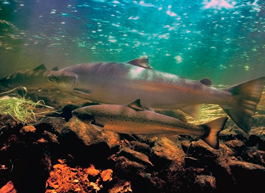home | north bay bohemian index | news | north bay | news article

Courtesy NOAA
SOMETHING FISH: California's coho salmon are among several salmon species bordering on extinction, according to a new report from California Trout.
Troubled Waters
The Golden State's trout and salmon are in peril, and that's bad news for humans
By Traci Hukill
T wo years ago, UC Davis biologist Peter Moyle set out to document the condition of California's salmon and trout. The findings took him by surprise.
"Basically, two things impressed me," says Moyle. "One was how many fish were in trouble. I had a feeling things were not good, but I didn't realize collectively how many were in serious trouble.
"The second thing that surprised me, though, is how many of these fish are hanging in there."
Moyle's research, commissioned by the sportfishing group California Trout and summarized in SOS: California's Native Fish Crisis, found that if present trends continue, 65 percent of California's native trout and salmon will be extinct within a hundred years. Moyle and his fellow researchers applied seven criteria to each of the state's 32 salmonids (a family that includes trout) and came up with an index. On a scale of 0 to 5, with 0 being "extinct" and 5 being healthy, 20 of the fish scored a 2 or lower. Only five scored a 4 or 5. The state's 12 salmon species are under particular pressure; 83 percent of them could vanish in the next century.
"Only two populations of Chinook are at low risk of extinction, but even these are declining," Moyle told reporters at a press conference last month announcing the results. "At the end of the century, they'll be curiosities."
On the other hand, Moyle points out, most of the fish still persist in their native range, albeit in small pockets. "Like the steelhead in Southern California—that's truly amazing," he says. "So the fact that these fish are still maintaining marginal populations in so many areas tells you conservation efforts are worthwhile."
California Trout is being careful to relate the findings to human self-interest and to supply suggestions for how government agencies—specifically the Department of Fish and Game (DFG)—can act to preserve salmonids.
"At its core, this report and its findings are really about cold, clean water—absolute requirements for healthy fisheries, but also absolute requirements for our very own livelihoods," says California Trout CEO Brian Stranko.
"The recent Klamath agreement [to remove four dams] and the coming restoration of the San Joaquin [River] all provide hope. We can engage in more large-scale restoration projects, and we can adapt our land use practices—how we farm, how we graze cattle—but we need to start doing this right now."
He adds that California also needs a robust DFG. "We understand that DFG has budget challenges in an economic downturn, but we also understand that if we lose fish, we lose valuable inputs to our economy."
Of the three salmonids that rated a 1—meaning highly vulnerable to extinction in the next 50 years—the Central California Coast coho historically had the broadest range, extending from Punta Gorda to the San Lorenzo in Santa Cruz County. The others, pink and chum salmon, exist only in Northern California and never in historically large numbers.
Coho watchers got a sour surprise earlier this year when adults came back to spawn in pitiful numbers that represented a 70 percent decline from previous years. In Scott Creek, at the southern end of the fish's range, just 11 fish returned to spawn, and only one was female. Redwood Creek in Marin had no returning coho at all.
Sean Hayes, a biologist with the National Marine Fisheries Service, says it's too early to tell what the coho return will be like this year. It takes a good, healthy rain to breach the sandbar at the end of creeks like Scott, Waddell and Lagunitas so that the coho that have been feeding in the ocean can make it back upstream to spawn. Hayes says that usually happens in mid-December, with the first serious storm of the season.
Hayes, who primarily does research in Scott Creek, anticipates low returns to the waterway this year. "We're probably expecting somewhere on the order of 50 fish, if things are mediocre to slightly poor, to 100 if things go really well," he says. "A good year of coho in the creek is 300 or more fish. Two hundred we're happy with, and 100 we can get by with. And less than that and we're worried."
Moyle is blunt about the prognosis for the coho.
"The only sign of hope for this species is Lagunitas Creek in Marin County," he says. "It still has annual runs of about 500 fish coming up the creek."
But even Lagunitas, with its protections and informed population, can't save the coho. Moyle says salmonids rely on multiple populations to protect against accidents like pesticide spills or bad localized ocean conditions.
"The idea of a single population for anadromous fish like salmon is always bad news," Moyle says. "Random things can happen to any salmon population, and you not only lose that population, you lose the species."
Send a letter to the editor about this story.
|
|
|
|
|
|